The Uniform Evidence Act and the Rights of First Nation People
VerifiedAdded on 2022/11/29
|9
|2236
|383
Essay
AI Summary
This essay delves into the complexities surrounding the Uniform Evidence Act and its application to First Nation People in Australia, focusing on the privilege against self-incrimination. It examines the historical context, the Australian Common Law principles, and the differing perspectives on justice held by Aboriginal communities. The essay explores the recommendations of the Australian Law Reform Commission (ALRC), particularly the debate over extending the privilege to protect First Nation witnesses from incriminating themselves under customary laws. It analyzes the arguments for and against such an extension, considering the potential impact on legal proceedings, the balance between individual rights and the pursuit of justice, and the flexibility of the current legal framework. The essay also references foreign jurisdictions and relevant case law to support its analysis, ultimately concluding that extending the privilege against self-incrimination under the Uniform Evidence Act would be impractical and potentially detrimental to the First Nations People.
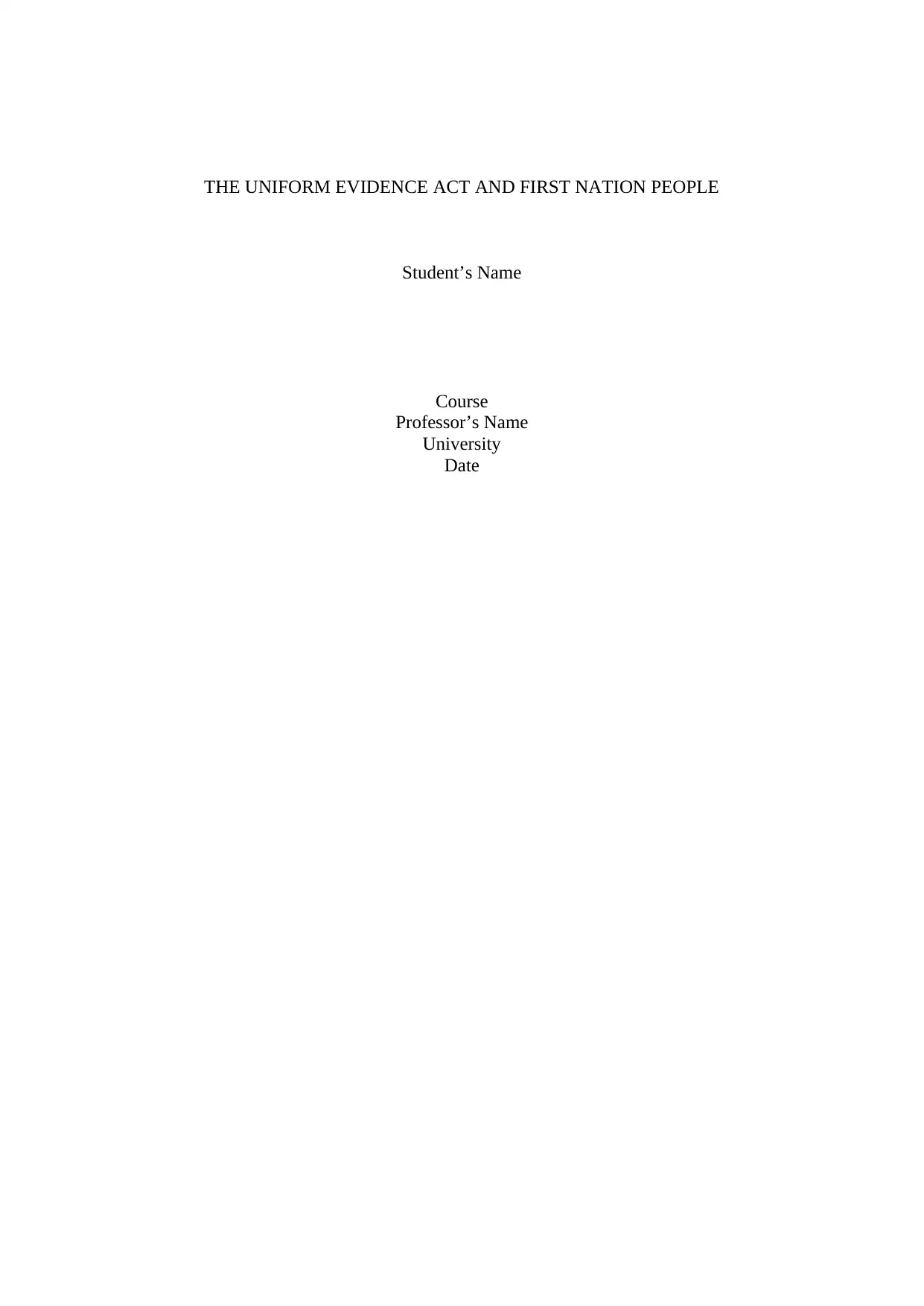
THE UNIFORM EVIDENCE ACT AND FIRST NATION PEOPLE
Student’s Name
Course
Professor’s Name
University
Date
Student’s Name
Course
Professor’s Name
University
Date
Paraphrase This Document
Need a fresh take? Get an instant paraphrase of this document with our AI Paraphraser
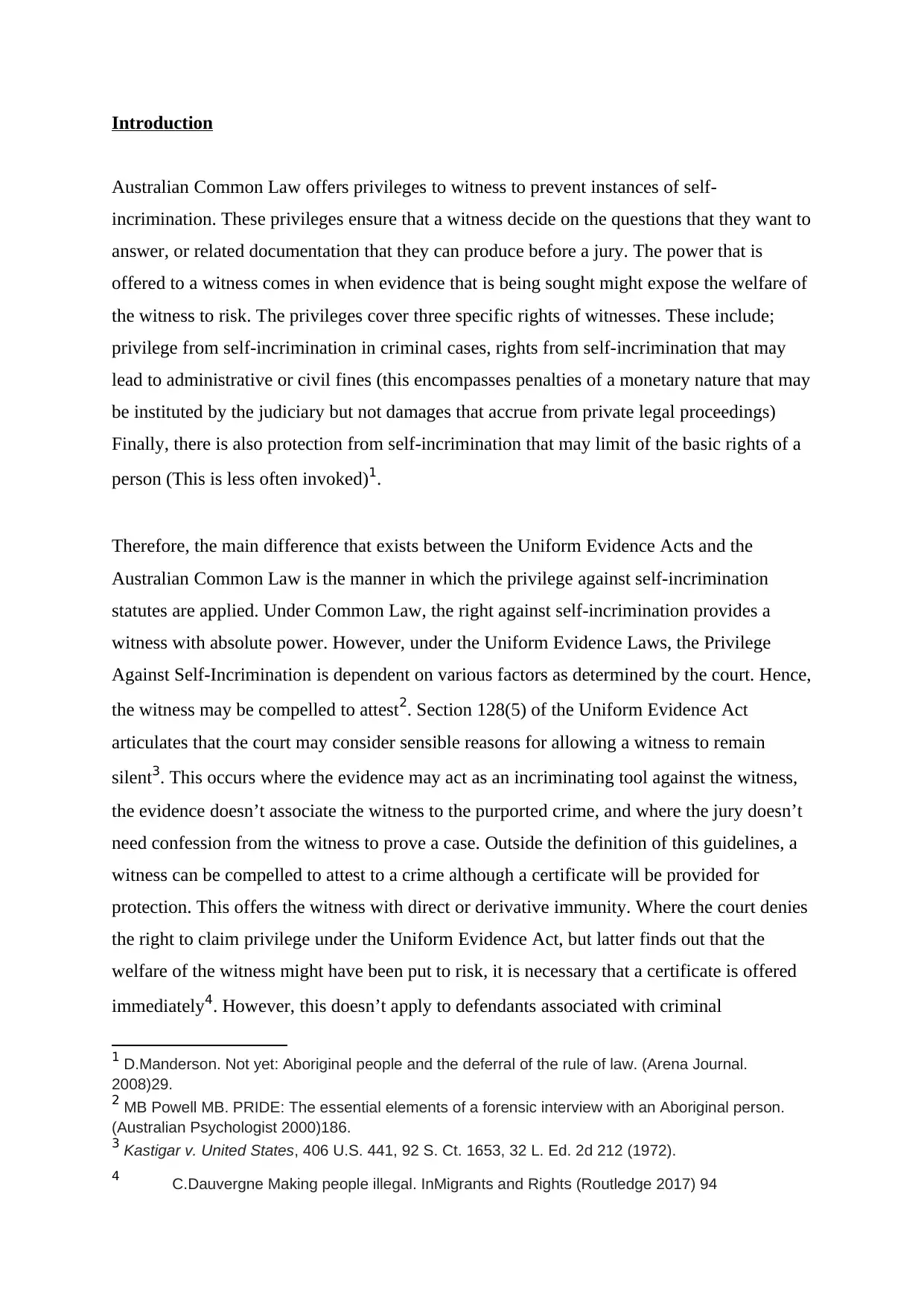
Introduction
Australian Common Law offers privileges to witness to prevent instances of self-
incrimination. These privileges ensure that a witness decide on the questions that they want to
answer, or related documentation that they can produce before a jury. The power that is
offered to a witness comes in when evidence that is being sought might expose the welfare of
the witness to risk. The privileges cover three specific rights of witnesses. These include;
privilege from self-incrimination in criminal cases, rights from self-incrimination that may
lead to administrative or civil fines (this encompasses penalties of a monetary nature that may
be instituted by the judiciary but not damages that accrue from private legal proceedings)
Finally, there is also protection from self-incrimination that may limit of the basic rights of a
person (This is less often invoked)1.
Therefore, the main difference that exists between the Uniform Evidence Acts and the
Australian Common Law is the manner in which the privilege against self-incrimination
statutes are applied. Under Common Law, the right against self-incrimination provides a
witness with absolute power. However, under the Uniform Evidence Laws, the Privilege
Against Self-Incrimination is dependent on various factors as determined by the court. Hence,
the witness may be compelled to attest2. Section 128(5) of the Uniform Evidence Act
articulates that the court may consider sensible reasons for allowing a witness to remain
silent3. This occurs where the evidence may act as an incriminating tool against the witness,
the evidence doesn’t associate the witness to the purported crime, and where the jury doesn’t
need confession from the witness to prove a case. Outside the definition of this guidelines, a
witness can be compelled to attest to a crime although a certificate will be provided for
protection. This offers the witness with direct or derivative immunity. Where the court denies
the right to claim privilege under the Uniform Evidence Act, but latter finds out that the
welfare of the witness might have been put to risk, it is necessary that a certificate is offered
immediately4. However, this doesn’t apply to defendants associated with criminal
1 D.Manderson. Not yet: Aboriginal people and the deferral of the rule of law. (Arena Journal.
2008)29.
2 MB Powell MB. PRIDE: The essential elements of a forensic interview with an Aboriginal person.
(Australian Psychologist 2000)186.
3 Kastigar v. United States, 406 U.S. 441, 92 S. Ct. 1653, 32 L. Ed. 2d 212 (1972).
4 C.Dauvergne Making people illegal. InMigrants and Rights (Routledge 2017) 94
Australian Common Law offers privileges to witness to prevent instances of self-
incrimination. These privileges ensure that a witness decide on the questions that they want to
answer, or related documentation that they can produce before a jury. The power that is
offered to a witness comes in when evidence that is being sought might expose the welfare of
the witness to risk. The privileges cover three specific rights of witnesses. These include;
privilege from self-incrimination in criminal cases, rights from self-incrimination that may
lead to administrative or civil fines (this encompasses penalties of a monetary nature that may
be instituted by the judiciary but not damages that accrue from private legal proceedings)
Finally, there is also protection from self-incrimination that may limit of the basic rights of a
person (This is less often invoked)1.
Therefore, the main difference that exists between the Uniform Evidence Acts and the
Australian Common Law is the manner in which the privilege against self-incrimination
statutes are applied. Under Common Law, the right against self-incrimination provides a
witness with absolute power. However, under the Uniform Evidence Laws, the Privilege
Against Self-Incrimination is dependent on various factors as determined by the court. Hence,
the witness may be compelled to attest2. Section 128(5) of the Uniform Evidence Act
articulates that the court may consider sensible reasons for allowing a witness to remain
silent3. This occurs where the evidence may act as an incriminating tool against the witness,
the evidence doesn’t associate the witness to the purported crime, and where the jury doesn’t
need confession from the witness to prove a case. Outside the definition of this guidelines, a
witness can be compelled to attest to a crime although a certificate will be provided for
protection. This offers the witness with direct or derivative immunity. Where the court denies
the right to claim privilege under the Uniform Evidence Act, but latter finds out that the
welfare of the witness might have been put to risk, it is necessary that a certificate is offered
immediately4. However, this doesn’t apply to defendants associated with criminal
1 D.Manderson. Not yet: Aboriginal people and the deferral of the rule of law. (Arena Journal.
2008)29.
2 MB Powell MB. PRIDE: The essential elements of a forensic interview with an Aboriginal person.
(Australian Psychologist 2000)186.
3 Kastigar v. United States, 406 U.S. 441, 92 S. Ct. 1653, 32 L. Ed. 2d 212 (1972).
4 C.Dauvergne Making people illegal. InMigrants and Rights (Routledge 2017) 94
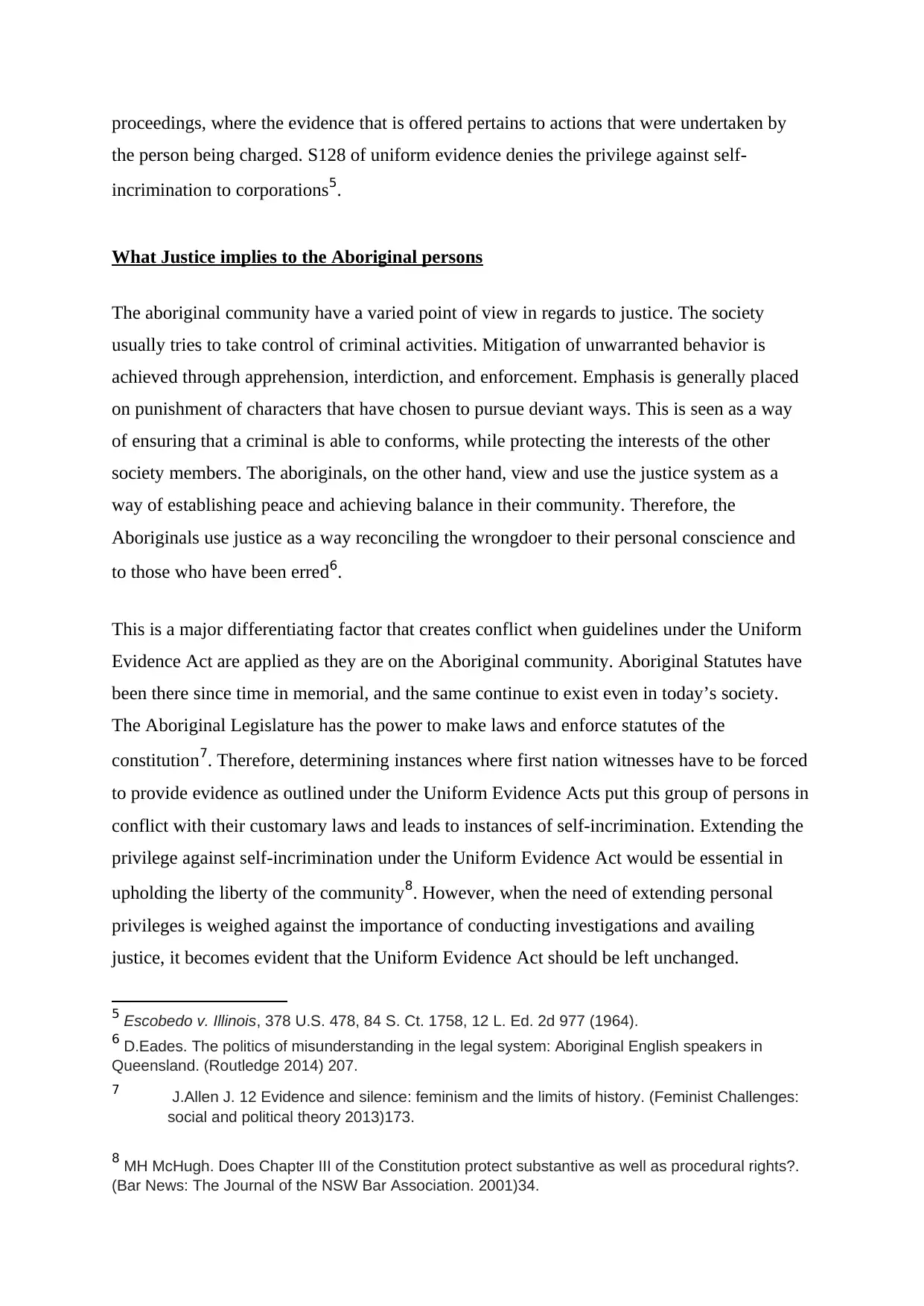
proceedings, where the evidence that is offered pertains to actions that were undertaken by
the person being charged. S128 of uniform evidence denies the privilege against self-
incrimination to corporations5.
What Justice implies to the Aboriginal persons
The aboriginal community have a varied point of view in regards to justice. The society
usually tries to take control of criminal activities. Mitigation of unwarranted behavior is
achieved through apprehension, interdiction, and enforcement. Emphasis is generally placed
on punishment of characters that have chosen to pursue deviant ways. This is seen as a way
of ensuring that a criminal is able to conforms, while protecting the interests of the other
society members. The aboriginals, on the other hand, view and use the justice system as a
way of establishing peace and achieving balance in their community. Therefore, the
Aboriginals use justice as a way reconciling the wrongdoer to their personal conscience and
to those who have been erred6.
This is a major differentiating factor that creates conflict when guidelines under the Uniform
Evidence Act are applied as they are on the Aboriginal community. Aboriginal Statutes have
been there since time in memorial, and the same continue to exist even in today’s society.
The Aboriginal Legislature has the power to make laws and enforce statutes of the
constitution7. Therefore, determining instances where first nation witnesses have to be forced
to provide evidence as outlined under the Uniform Evidence Acts put this group of persons in
conflict with their customary laws and leads to instances of self-incrimination. Extending the
privilege against self-incrimination under the Uniform Evidence Act would be essential in
upholding the liberty of the community8. However, when the need of extending personal
privileges is weighed against the importance of conducting investigations and availing
justice, it becomes evident that the Uniform Evidence Act should be left unchanged.
5 Escobedo v. Illinois, 378 U.S. 478, 84 S. Ct. 1758, 12 L. Ed. 2d 977 (1964).
6 D.Eades. The politics of misunderstanding in the legal system: Aboriginal English speakers in
Queensland. (Routledge 2014) 207.
7 J.Allen J. 12 Evidence and silence: feminism and the limits of history. (Feminist Challenges:
social and political theory 2013)173.
8 MH McHugh. Does Chapter III of the Constitution protect substantive as well as procedural rights?.
(Bar News: The Journal of the NSW Bar Association. 2001)34.
the person being charged. S128 of uniform evidence denies the privilege against self-
incrimination to corporations5.
What Justice implies to the Aboriginal persons
The aboriginal community have a varied point of view in regards to justice. The society
usually tries to take control of criminal activities. Mitigation of unwarranted behavior is
achieved through apprehension, interdiction, and enforcement. Emphasis is generally placed
on punishment of characters that have chosen to pursue deviant ways. This is seen as a way
of ensuring that a criminal is able to conforms, while protecting the interests of the other
society members. The aboriginals, on the other hand, view and use the justice system as a
way of establishing peace and achieving balance in their community. Therefore, the
Aboriginals use justice as a way reconciling the wrongdoer to their personal conscience and
to those who have been erred6.
This is a major differentiating factor that creates conflict when guidelines under the Uniform
Evidence Act are applied as they are on the Aboriginal community. Aboriginal Statutes have
been there since time in memorial, and the same continue to exist even in today’s society.
The Aboriginal Legislature has the power to make laws and enforce statutes of the
constitution7. Therefore, determining instances where first nation witnesses have to be forced
to provide evidence as outlined under the Uniform Evidence Acts put this group of persons in
conflict with their customary laws and leads to instances of self-incrimination. Extending the
privilege against self-incrimination under the Uniform Evidence Act would be essential in
upholding the liberty of the community8. However, when the need of extending personal
privileges is weighed against the importance of conducting investigations and availing
justice, it becomes evident that the Uniform Evidence Act should be left unchanged.
5 Escobedo v. Illinois, 378 U.S. 478, 84 S. Ct. 1758, 12 L. Ed. 2d 977 (1964).
6 D.Eades. The politics of misunderstanding in the legal system: Aboriginal English speakers in
Queensland. (Routledge 2014) 207.
7 J.Allen J. 12 Evidence and silence: feminism and the limits of history. (Feminist Challenges:
social and political theory 2013)173.
8 MH McHugh. Does Chapter III of the Constitution protect substantive as well as procedural rights?.
(Bar News: The Journal of the NSW Bar Association. 2001)34.
⊘ This is a preview!⊘
Do you want full access?
Subscribe today to unlock all pages.

Trusted by 1+ million students worldwide
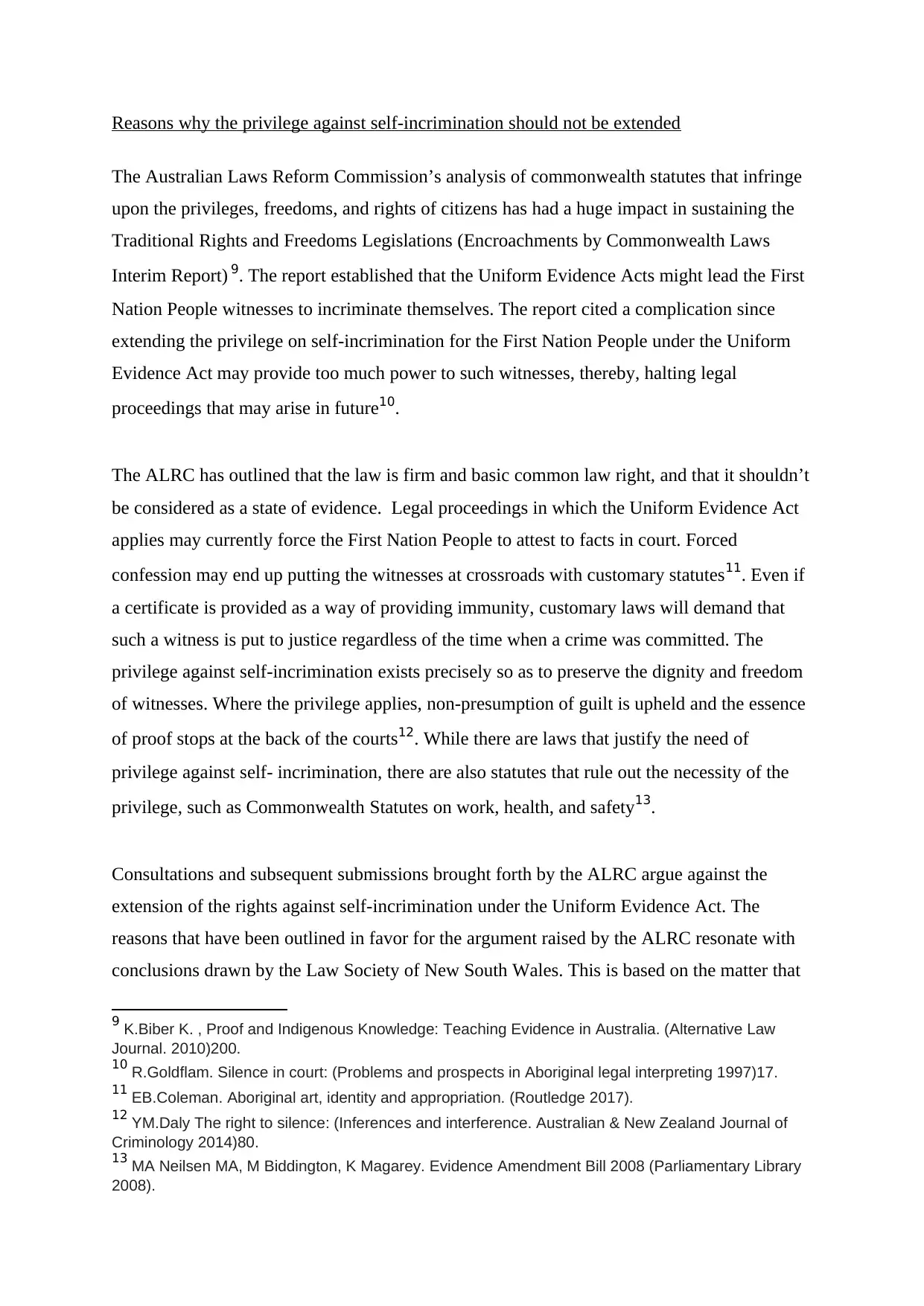
Reasons why the privilege against self-incrimination should not be extended
The Australian Laws Reform Commission’s analysis of commonwealth statutes that infringe
upon the privileges, freedoms, and rights of citizens has had a huge impact in sustaining the
Traditional Rights and Freedoms Legislations (Encroachments by Commonwealth Laws
Interim Report) 9. The report established that the Uniform Evidence Acts might lead the First
Nation People witnesses to incriminate themselves. The report cited a complication since
extending the privilege on self-incrimination for the First Nation People under the Uniform
Evidence Act may provide too much power to such witnesses, thereby, halting legal
proceedings that may arise in future10.
The ALRC has outlined that the law is firm and basic common law right, and that it shouldn’t
be considered as a state of evidence. Legal proceedings in which the Uniform Evidence Act
applies may currently force the First Nation People to attest to facts in court. Forced
confession may end up putting the witnesses at crossroads with customary statutes11. Even if
a certificate is provided as a way of providing immunity, customary laws will demand that
such a witness is put to justice regardless of the time when a crime was committed. The
privilege against self-incrimination exists precisely so as to preserve the dignity and freedom
of witnesses. Where the privilege applies, non-presumption of guilt is upheld and the essence
of proof stops at the back of the courts12. While there are laws that justify the need of
privilege against self- incrimination, there are also statutes that rule out the necessity of the
privilege, such as Commonwealth Statutes on work, health, and safety13.
Consultations and subsequent submissions brought forth by the ALRC argue against the
extension of the rights against self-incrimination under the Uniform Evidence Act. The
reasons that have been outlined in favor for the argument raised by the ALRC resonate with
conclusions drawn by the Law Society of New South Wales. This is based on the matter that
9 K.Biber K. , Proof and Indigenous Knowledge: Teaching Evidence in Australia. (Alternative Law
Journal. 2010)200.
10 R.Goldflam. Silence in court: (Problems and prospects in Aboriginal legal interpreting 1997)17.
11 EB.Coleman. Aboriginal art, identity and appropriation. (Routledge 2017).
12 YM.Daly The right to silence: (Inferences and interference. Australian & New Zealand Journal of
Criminology 2014)80.
13 MA Neilsen MA, M Biddington, K Magarey. Evidence Amendment Bill 2008 (Parliamentary Library
2008).
The Australian Laws Reform Commission’s analysis of commonwealth statutes that infringe
upon the privileges, freedoms, and rights of citizens has had a huge impact in sustaining the
Traditional Rights and Freedoms Legislations (Encroachments by Commonwealth Laws
Interim Report) 9. The report established that the Uniform Evidence Acts might lead the First
Nation People witnesses to incriminate themselves. The report cited a complication since
extending the privilege on self-incrimination for the First Nation People under the Uniform
Evidence Act may provide too much power to such witnesses, thereby, halting legal
proceedings that may arise in future10.
The ALRC has outlined that the law is firm and basic common law right, and that it shouldn’t
be considered as a state of evidence. Legal proceedings in which the Uniform Evidence Act
applies may currently force the First Nation People to attest to facts in court. Forced
confession may end up putting the witnesses at crossroads with customary statutes11. Even if
a certificate is provided as a way of providing immunity, customary laws will demand that
such a witness is put to justice regardless of the time when a crime was committed. The
privilege against self-incrimination exists precisely so as to preserve the dignity and freedom
of witnesses. Where the privilege applies, non-presumption of guilt is upheld and the essence
of proof stops at the back of the courts12. While there are laws that justify the need of
privilege against self- incrimination, there are also statutes that rule out the necessity of the
privilege, such as Commonwealth Statutes on work, health, and safety13.
Consultations and subsequent submissions brought forth by the ALRC argue against the
extension of the rights against self-incrimination under the Uniform Evidence Act. The
reasons that have been outlined in favor for the argument raised by the ALRC resonate with
conclusions drawn by the Law Society of New South Wales. This is based on the matter that
9 K.Biber K. , Proof and Indigenous Knowledge: Teaching Evidence in Australia. (Alternative Law
Journal. 2010)200.
10 R.Goldflam. Silence in court: (Problems and prospects in Aboriginal legal interpreting 1997)17.
11 EB.Coleman. Aboriginal art, identity and appropriation. (Routledge 2017).
12 YM.Daly The right to silence: (Inferences and interference. Australian & New Zealand Journal of
Criminology 2014)80.
13 MA Neilsen MA, M Biddington, K Magarey. Evidence Amendment Bill 2008 (Parliamentary Library
2008).
Paraphrase This Document
Need a fresh take? Get an instant paraphrase of this document with our AI Paraphraser
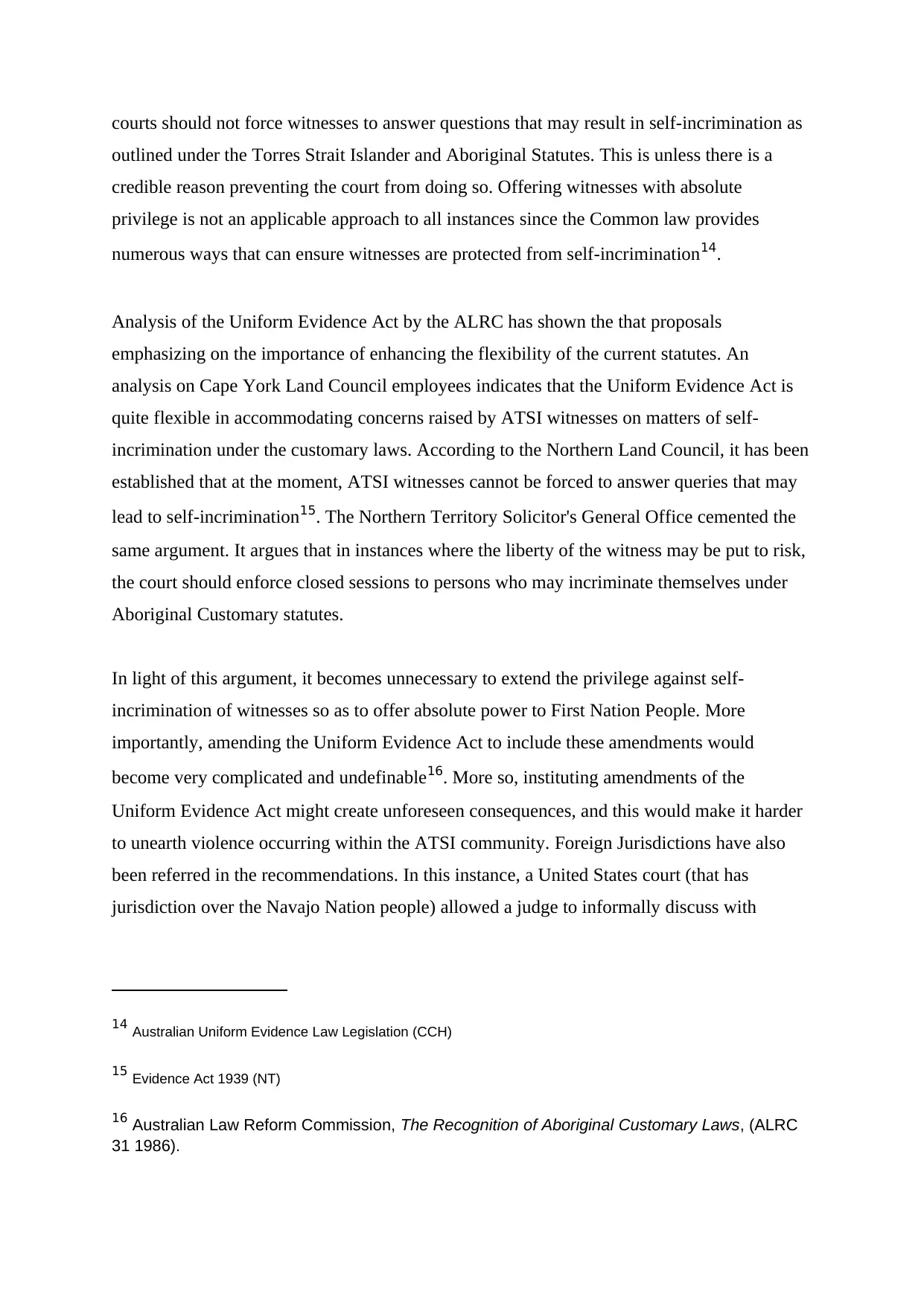
courts should not force witnesses to answer questions that may result in self-incrimination as
outlined under the Torres Strait Islander and Aboriginal Statutes. This is unless there is a
credible reason preventing the court from doing so. Offering witnesses with absolute
privilege is not an applicable approach to all instances since the Common law provides
numerous ways that can ensure witnesses are protected from self-incrimination14.
Analysis of the Uniform Evidence Act by the ALRC has shown the that proposals
emphasizing on the importance of enhancing the flexibility of the current statutes. An
analysis on Cape York Land Council employees indicates that the Uniform Evidence Act is
quite flexible in accommodating concerns raised by ATSI witnesses on matters of self-
incrimination under the customary laws. According to the Northern Land Council, it has been
established that at the moment, ATSI witnesses cannot be forced to answer queries that may
lead to self-incrimination15. The Northern Territory Solicitor's General Office cemented the
same argument. It argues that in instances where the liberty of the witness may be put to risk,
the court should enforce closed sessions to persons who may incriminate themselves under
Aboriginal Customary statutes.
In light of this argument, it becomes unnecessary to extend the privilege against self-
incrimination of witnesses so as to offer absolute power to First Nation People. More
importantly, amending the Uniform Evidence Act to include these amendments would
become very complicated and undefinable16. More so, instituting amendments of the
Uniform Evidence Act might create unforeseen consequences, and this would make it harder
to unearth violence occurring within the ATSI community. Foreign Jurisdictions have also
been referred in the recommendations. In this instance, a United States court (that has
jurisdiction over the Navajo Nation people) allowed a judge to informally discuss with
14 Australian Uniform Evidence Law Legislation (CCH)
15 Evidence Act 1939 (NT)
16 Australian Law Reform Commission, The Recognition of Aboriginal Customary Laws, (ALRC
31 1986).
outlined under the Torres Strait Islander and Aboriginal Statutes. This is unless there is a
credible reason preventing the court from doing so. Offering witnesses with absolute
privilege is not an applicable approach to all instances since the Common law provides
numerous ways that can ensure witnesses are protected from self-incrimination14.
Analysis of the Uniform Evidence Act by the ALRC has shown the that proposals
emphasizing on the importance of enhancing the flexibility of the current statutes. An
analysis on Cape York Land Council employees indicates that the Uniform Evidence Act is
quite flexible in accommodating concerns raised by ATSI witnesses on matters of self-
incrimination under the customary laws. According to the Northern Land Council, it has been
established that at the moment, ATSI witnesses cannot be forced to answer queries that may
lead to self-incrimination15. The Northern Territory Solicitor's General Office cemented the
same argument. It argues that in instances where the liberty of the witness may be put to risk,
the court should enforce closed sessions to persons who may incriminate themselves under
Aboriginal Customary statutes.
In light of this argument, it becomes unnecessary to extend the privilege against self-
incrimination of witnesses so as to offer absolute power to First Nation People. More
importantly, amending the Uniform Evidence Act to include these amendments would
become very complicated and undefinable16. More so, instituting amendments of the
Uniform Evidence Act might create unforeseen consequences, and this would make it harder
to unearth violence occurring within the ATSI community. Foreign Jurisdictions have also
been referred in the recommendations. In this instance, a United States court (that has
jurisdiction over the Navajo Nation people) allowed a judge to informally discuss with
14 Australian Uniform Evidence Law Legislation (CCH)
15 Evidence Act 1939 (NT)
16 Australian Law Reform Commission, The Recognition of Aboriginal Customary Laws, (ALRC
31 1986).
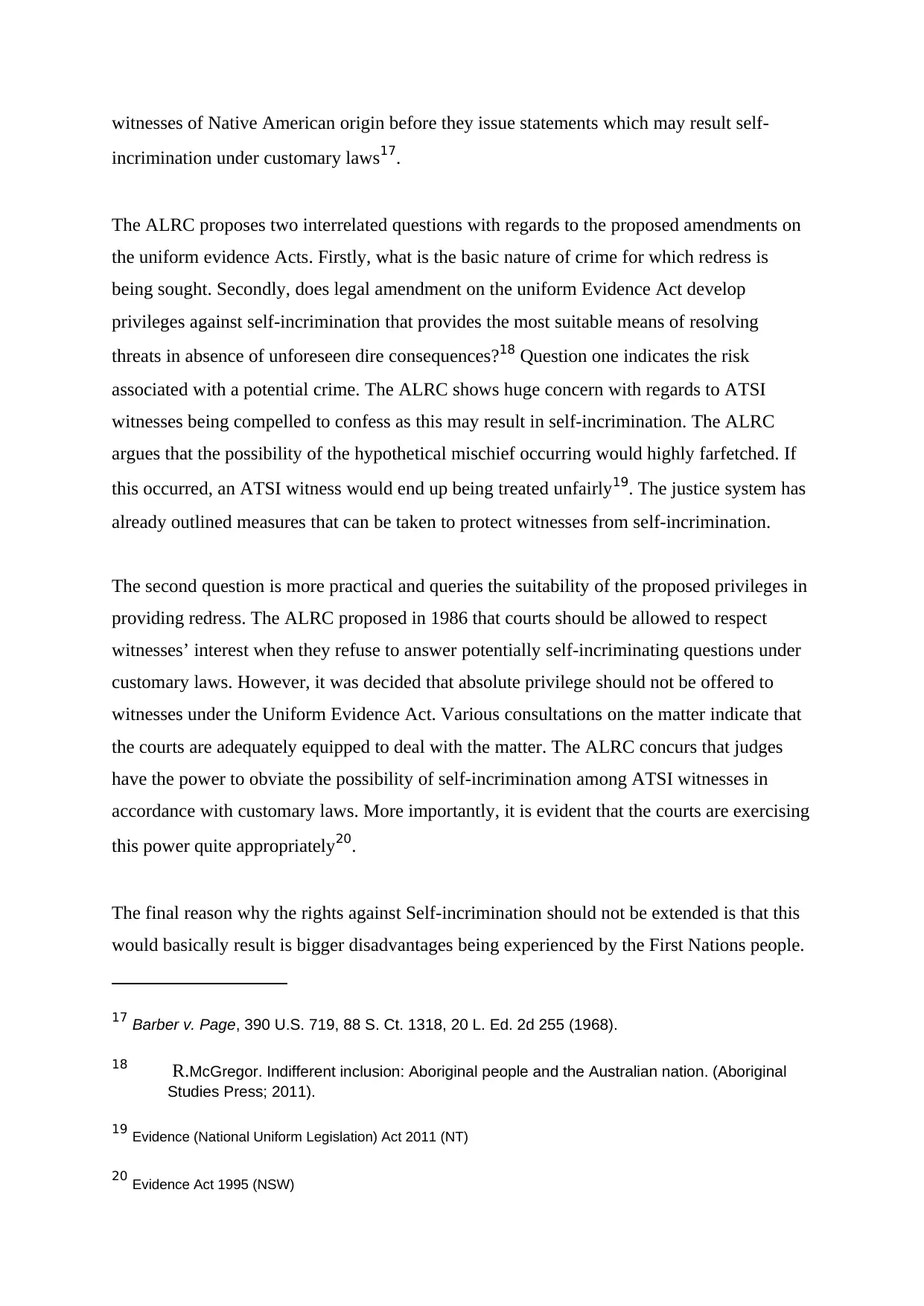
witnesses of Native American origin before they issue statements which may result self-
incrimination under customary laws17.
The ALRC proposes two interrelated questions with regards to the proposed amendments on
the uniform evidence Acts. Firstly, what is the basic nature of crime for which redress is
being sought. Secondly, does legal amendment on the uniform Evidence Act develop
privileges against self-incrimination that provides the most suitable means of resolving
threats in absence of unforeseen dire consequences?18 Question one indicates the risk
associated with a potential crime. The ALRC shows huge concern with regards to ATSI
witnesses being compelled to confess as this may result in self-incrimination. The ALRC
argues that the possibility of the hypothetical mischief occurring would highly farfetched. If
this occurred, an ATSI witness would end up being treated unfairly19. The justice system has
already outlined measures that can be taken to protect witnesses from self-incrimination.
The second question is more practical and queries the suitability of the proposed privileges in
providing redress. The ALRC proposed in 1986 that courts should be allowed to respect
witnesses’ interest when they refuse to answer potentially self-incriminating questions under
customary laws. However, it was decided that absolute privilege should not be offered to
witnesses under the Uniform Evidence Act. Various consultations on the matter indicate that
the courts are adequately equipped to deal with the matter. The ALRC concurs that judges
have the power to obviate the possibility of self-incrimination among ATSI witnesses in
accordance with customary laws. More importantly, it is evident that the courts are exercising
this power quite appropriately20.
The final reason why the rights against Self-incrimination should not be extended is that this
would basically result is bigger disadvantages being experienced by the First Nations people.
17 Barber v. Page, 390 U.S. 719, 88 S. Ct. 1318, 20 L. Ed. 2d 255 (1968).
18 R.McGregor. Indifferent inclusion: Aboriginal people and the Australian nation. (Aboriginal
Studies Press; 2011).
19 Evidence (National Uniform Legislation) Act 2011 (NT)
20 Evidence Act 1995 (NSW)
incrimination under customary laws17.
The ALRC proposes two interrelated questions with regards to the proposed amendments on
the uniform evidence Acts. Firstly, what is the basic nature of crime for which redress is
being sought. Secondly, does legal amendment on the uniform Evidence Act develop
privileges against self-incrimination that provides the most suitable means of resolving
threats in absence of unforeseen dire consequences?18 Question one indicates the risk
associated with a potential crime. The ALRC shows huge concern with regards to ATSI
witnesses being compelled to confess as this may result in self-incrimination. The ALRC
argues that the possibility of the hypothetical mischief occurring would highly farfetched. If
this occurred, an ATSI witness would end up being treated unfairly19. The justice system has
already outlined measures that can be taken to protect witnesses from self-incrimination.
The second question is more practical and queries the suitability of the proposed privileges in
providing redress. The ALRC proposed in 1986 that courts should be allowed to respect
witnesses’ interest when they refuse to answer potentially self-incriminating questions under
customary laws. However, it was decided that absolute privilege should not be offered to
witnesses under the Uniform Evidence Act. Various consultations on the matter indicate that
the courts are adequately equipped to deal with the matter. The ALRC concurs that judges
have the power to obviate the possibility of self-incrimination among ATSI witnesses in
accordance with customary laws. More importantly, it is evident that the courts are exercising
this power quite appropriately20.
The final reason why the rights against Self-incrimination should not be extended is that this
would basically result is bigger disadvantages being experienced by the First Nations people.
17 Barber v. Page, 390 U.S. 719, 88 S. Ct. 1318, 20 L. Ed. 2d 255 (1968).
18 R.McGregor. Indifferent inclusion: Aboriginal people and the Australian nation. (Aboriginal
Studies Press; 2011).
19 Evidence (National Uniform Legislation) Act 2011 (NT)
20 Evidence Act 1995 (NSW)
⊘ This is a preview!⊘
Do you want full access?
Subscribe today to unlock all pages.

Trusted by 1+ million students worldwide
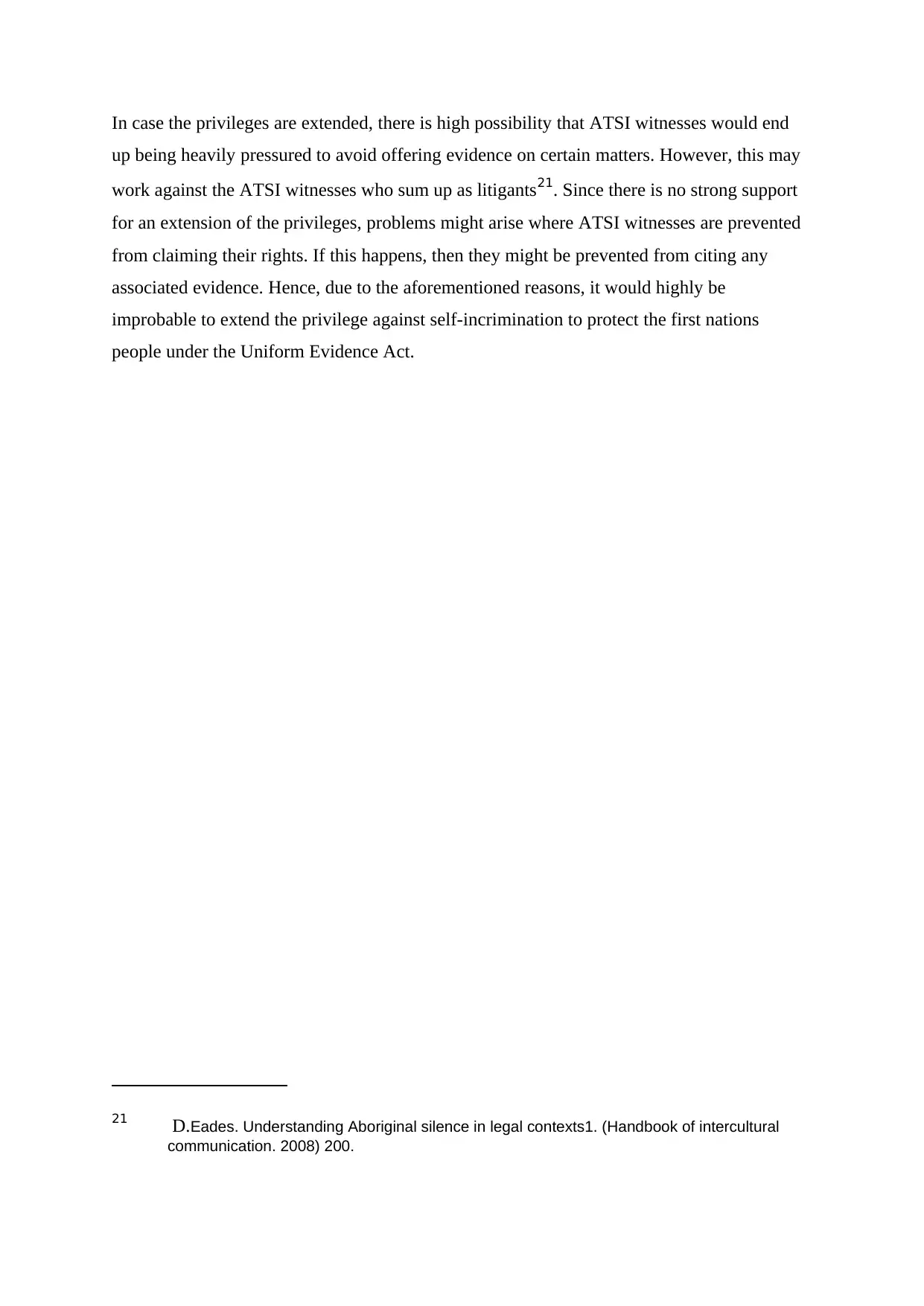
In case the privileges are extended, there is high possibility that ATSI witnesses would end
up being heavily pressured to avoid offering evidence on certain matters. However, this may
work against the ATSI witnesses who sum up as litigants21. Since there is no strong support
for an extension of the privileges, problems might arise where ATSI witnesses are prevented
from claiming their rights. If this happens, then they might be prevented from citing any
associated evidence. Hence, due to the aforementioned reasons, it would highly be
improbable to extend the privilege against self-incrimination to protect the first nations
people under the Uniform Evidence Act.
21 D.Eades. Understanding Aboriginal silence in legal contexts1. (Handbook of intercultural
communication. 2008) 200.
up being heavily pressured to avoid offering evidence on certain matters. However, this may
work against the ATSI witnesses who sum up as litigants21. Since there is no strong support
for an extension of the privileges, problems might arise where ATSI witnesses are prevented
from claiming their rights. If this happens, then they might be prevented from citing any
associated evidence. Hence, due to the aforementioned reasons, it would highly be
improbable to extend the privilege against self-incrimination to protect the first nations
people under the Uniform Evidence Act.
21 D.Eades. Understanding Aboriginal silence in legal contexts1. (Handbook of intercultural
communication. 2008) 200.
Paraphrase This Document
Need a fresh take? Get an instant paraphrase of this document with our AI Paraphraser
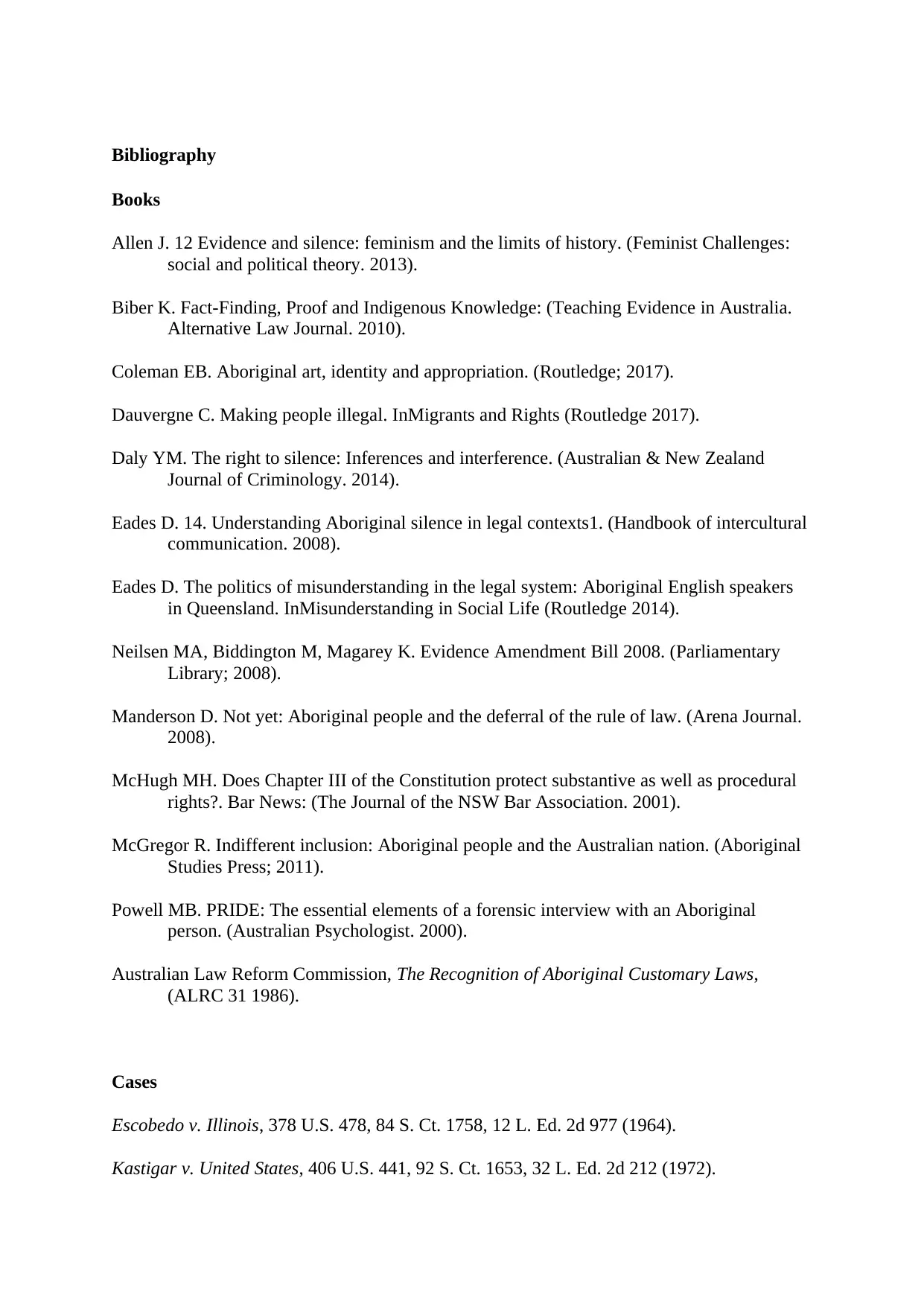
Bibliography
Books
Allen J. 12 Evidence and silence: feminism and the limits of history. (Feminist Challenges:
social and political theory. 2013).
Biber K. Fact-Finding, Proof and Indigenous Knowledge: (Teaching Evidence in Australia.
Alternative Law Journal. 2010).
Coleman EB. Aboriginal art, identity and appropriation. (Routledge; 2017).
Dauvergne C. Making people illegal. InMigrants and Rights (Routledge 2017).
Daly YM. The right to silence: Inferences and interference. (Australian & New Zealand
Journal of Criminology. 2014).
Eades D. 14. Understanding Aboriginal silence in legal contexts1. (Handbook of intercultural
communication. 2008).
Eades D. The politics of misunderstanding in the legal system: Aboriginal English speakers
in Queensland. InMisunderstanding in Social Life (Routledge 2014).
Neilsen MA, Biddington M, Magarey K. Evidence Amendment Bill 2008. (Parliamentary
Library; 2008).
Manderson D. Not yet: Aboriginal people and the deferral of the rule of law. (Arena Journal.
2008).
McHugh MH. Does Chapter III of the Constitution protect substantive as well as procedural
rights?. Bar News: (The Journal of the NSW Bar Association. 2001).
McGregor R. Indifferent inclusion: Aboriginal people and the Australian nation. (Aboriginal
Studies Press; 2011).
Powell MB. PRIDE: The essential elements of a forensic interview with an Aboriginal
person. (Australian Psychologist. 2000).
Australian Law Reform Commission, The Recognition of Aboriginal Customary Laws,
(ALRC 31 1986).
Cases
Escobedo v. Illinois, 378 U.S. 478, 84 S. Ct. 1758, 12 L. Ed. 2d 977 (1964).
Kastigar v. United States, 406 U.S. 441, 92 S. Ct. 1653, 32 L. Ed. 2d 212 (1972).
Books
Allen J. 12 Evidence and silence: feminism and the limits of history. (Feminist Challenges:
social and political theory. 2013).
Biber K. Fact-Finding, Proof and Indigenous Knowledge: (Teaching Evidence in Australia.
Alternative Law Journal. 2010).
Coleman EB. Aboriginal art, identity and appropriation. (Routledge; 2017).
Dauvergne C. Making people illegal. InMigrants and Rights (Routledge 2017).
Daly YM. The right to silence: Inferences and interference. (Australian & New Zealand
Journal of Criminology. 2014).
Eades D. 14. Understanding Aboriginal silence in legal contexts1. (Handbook of intercultural
communication. 2008).
Eades D. The politics of misunderstanding in the legal system: Aboriginal English speakers
in Queensland. InMisunderstanding in Social Life (Routledge 2014).
Neilsen MA, Biddington M, Magarey K. Evidence Amendment Bill 2008. (Parliamentary
Library; 2008).
Manderson D. Not yet: Aboriginal people and the deferral of the rule of law. (Arena Journal.
2008).
McHugh MH. Does Chapter III of the Constitution protect substantive as well as procedural
rights?. Bar News: (The Journal of the NSW Bar Association. 2001).
McGregor R. Indifferent inclusion: Aboriginal people and the Australian nation. (Aboriginal
Studies Press; 2011).
Powell MB. PRIDE: The essential elements of a forensic interview with an Aboriginal
person. (Australian Psychologist. 2000).
Australian Law Reform Commission, The Recognition of Aboriginal Customary Laws,
(ALRC 31 1986).
Cases
Escobedo v. Illinois, 378 U.S. 478, 84 S. Ct. 1758, 12 L. Ed. 2d 977 (1964).
Kastigar v. United States, 406 U.S. 441, 92 S. Ct. 1653, 32 L. Ed. 2d 212 (1972).
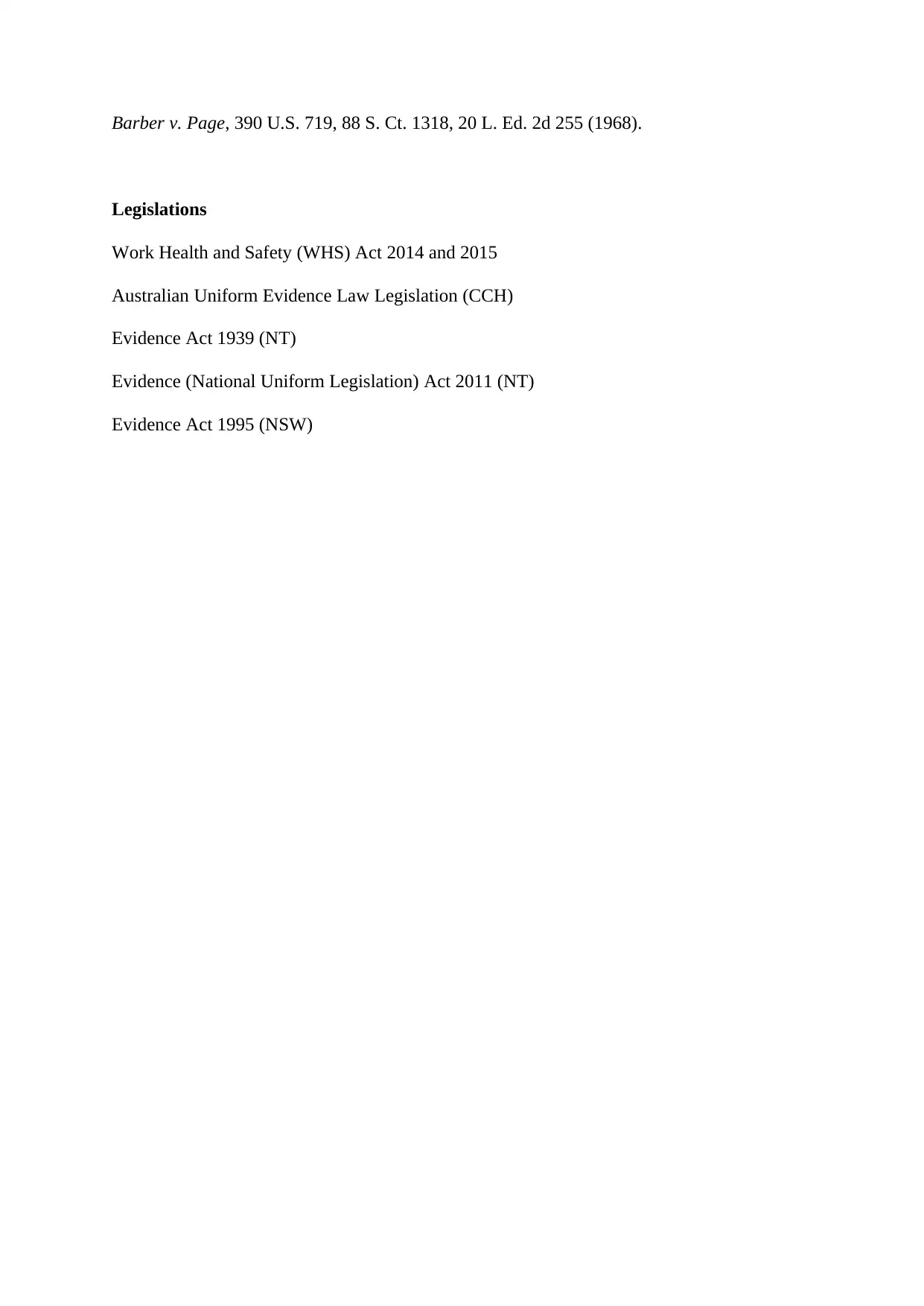
Barber v. Page, 390 U.S. 719, 88 S. Ct. 1318, 20 L. Ed. 2d 255 (1968).
Legislations
Work Health and Safety (WHS) Act 2014 and 2015
Australian Uniform Evidence Law Legislation (CCH)
Evidence Act 1939 (NT)
Evidence (National Uniform Legislation) Act 2011 (NT)
Evidence Act 1995 (NSW)
Legislations
Work Health and Safety (WHS) Act 2014 and 2015
Australian Uniform Evidence Law Legislation (CCH)
Evidence Act 1939 (NT)
Evidence (National Uniform Legislation) Act 2011 (NT)
Evidence Act 1995 (NSW)
⊘ This is a preview!⊘
Do you want full access?
Subscribe today to unlock all pages.

Trusted by 1+ million students worldwide
1 out of 9
Related Documents
Your All-in-One AI-Powered Toolkit for Academic Success.
+13062052269
info@desklib.com
Available 24*7 on WhatsApp / Email
![[object Object]](/_next/static/media/star-bottom.7253800d.svg)
Unlock your academic potential
Copyright © 2020–2025 A2Z Services. All Rights Reserved. Developed and managed by ZUCOL.





